Introduction - Higher Education Statistics 2014/15
In 2014/15, there were 161 publicly-funded UK higher education providers (HEPs). HESA holds data on these HE providers plus the privately funded HE provider, The University of Buckingham. This publication brings together student, staff and finance data collected by HESA at these UK HE providers; student loan information from Student Loans Company (SLC); participation rates from Organisation for Economic Co-operation and Development (OECD) plus contextual population statistics from Office for National Statistics (ONS).
For the first time, experimental statistics about Alternative Providers (APs) are included in the introduction table A. APs are Higher Education (HE) providers who do not receive recurrent funding from the Higher Education Funding Council for England (HEFCE) or other public bodies and who are not further education (FE) colleges. Eligible students can access loans and grants from the Student Loans Company (SLC) on specific courses, referred to as designated courses. In 2014/15, HESA has collected data from 63 APs which fall within the coverage of the HESA AP record. Provision of HE by APs in England is much wider than this; in the BIS report Understanding the Market of Alternative Higher Education Providers and their Students in 2014 it states that there were 732 APs as of spring 2014. Therefore, the AP SFR reports on partial coverage of the AP sector and the courses which are offered within it. Thus, the AP SFR does not report total student numbers enrolled at APs in England.
Student population
There were 2.3 million students studying at HE level at UK HEPs in 2014/15. The data for full-time and sandwich first degree students shows a steady increase over the last 5 years, resulting in a 7.2% rise since 2010/11 and 0.5% since 2013/14. In contrast, the total number of HE students studying at UK HEPs has fallen every year since 2010/11. Overall since 2010/11 the percentage change was -9.4%, and since 2013/14 the percentage change was -1.4%, which reflects a general decline in part-time study over the period and also coincides with the changes to the tuition fee arrangements introduced for undergraduates starting courses from 2012/13.
Table A provides more detail on students by level of study with comparisons between full-time and part-time, where full-time includes those following a full-time or sandwich programme. Since 2010/11, there has been a considerable drop in both full-time (-56.3%) and part-time (-54.0%) other undergraduate students. This may be in part because several HE providers re-classified their nursing courses from a diploma of HE to a first degree during this time (see Data Intelligence). For part-time postgraduate students the percentage change since 2013/14 was -1.0% compared with -16.5% percentage change since 2010/11.
Equivalent information on students studying at further education level can be found in the current Statistical First Release from the Skills Funding Agency and the Department for Education (previously published by the Department for Business, Innovation and Skills).
Over half (59.2%) of the 2,266,075 HE students were following a full-time first degree programme. The following pie chart illustrates the breakdown of HE students by level and mode of study.
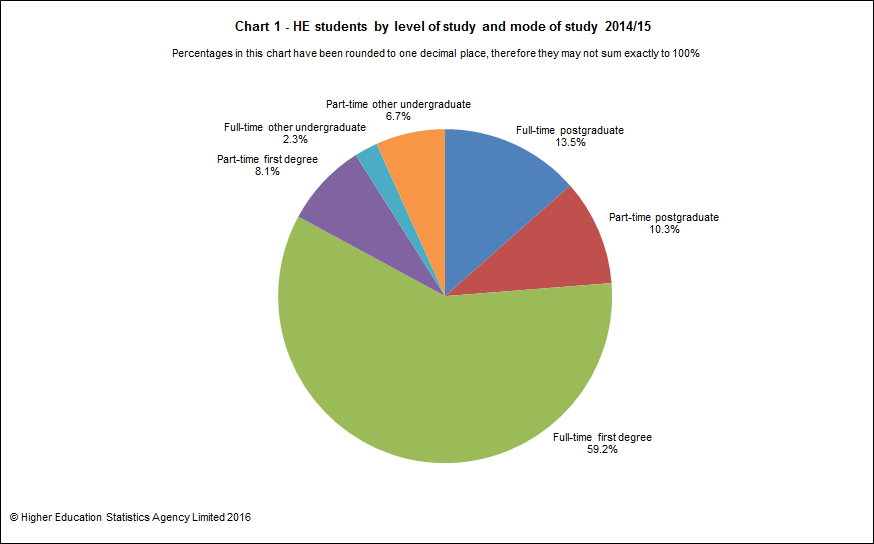
Sex and domicile
56.2% of all students studying at UK HEPs were female, 43.8% were male. The difference was more noticeable among students studying part-time of whom 60.3% were female and 39.7% were male.
Table B illustrates the differences in student numbers by level of study, mode of study, domicile and sex.
Subject of study
Table C shows that the distribution of HE student numbers by subject area varied by level of study.
For both postgraduate and first degree students, the highest percentages were studying Business & administrative studies (19.2% and 13.3% respectively). Postgraduate students also had a high percentage of students studing Education, which includes PGCE's, representing 15.1% of the total. 45.9% of first degree students were studying a science related subject. A significant percentage of other undergraduate students studied subjects allied to medicine (27.6%) and education (12.1%). The high percentage in subjects allied to medicine can be explained because a qualification below first degree level is common in many health-related professions, especially nursing. Many Open University students may not initially have to declare their award intention and are reported as studying for institutional credit in the combined subject area.
Chart 2 below provides the numbers of HE students by subject area and level of study.
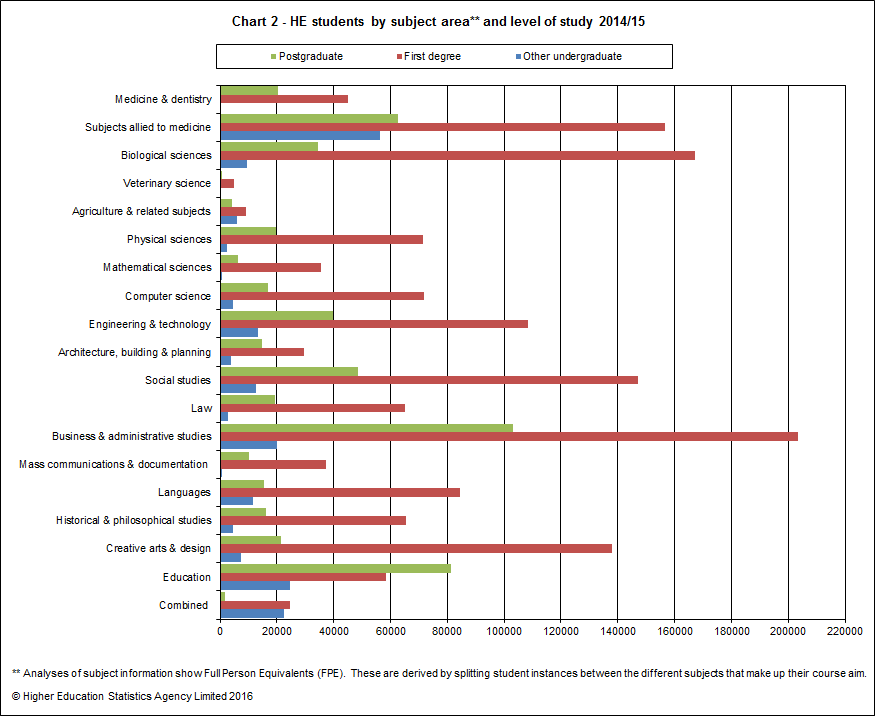
Qualifications obtained
In 2014/15 a total of 745,005 qualifications were awarded at HE level to students at UK HEPs. Of these, just over a third (35.1%) were at postgraduate level, 53.1% were first degree qualifications and 11.8% were other undergraduate qualifications. Chart 3 illustrates this.
2014/15 sees a 6.2% drop in the total number of first degree qualifiers, however the number of qualifiers is still 7.2% higher than in 2010/11. Table D provides a more detailed breakdown of qualifications obtained for the last five years.
Information on rates of completion for full-time first degrees are published separately in the ‘Projected Outcomes’ tables of the HESA Performance Indicators. These completion rates require two consecutive years’ data to produce so there is a time lag of one year between the latest data available (2014/15), and the latest completion rates (2013/14). The statistics show that the projected completion rate for UK domiciled full time first degrees increased slightly from 78.4% of 2009/10 entrants to 81.3% of 2013/14 entrants.
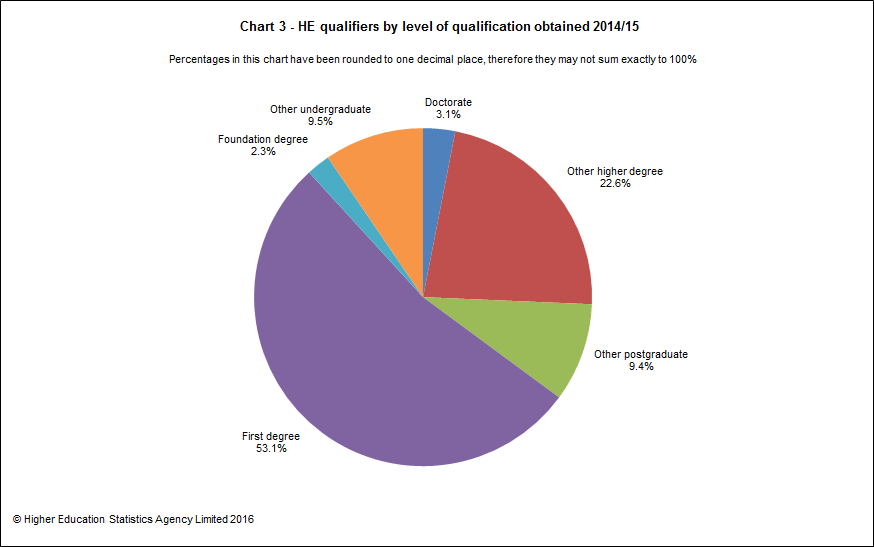
Destinations of leavers
The DLHE survey includes those qualifiers who completed their programmes during the academic year 2014/15. The reference date for those obtaining the qualification between 1 August 2014 and 31 December 2014 was 15 April 2015, and the reference date for those obtaining the qualification between 1 January 2015 and 31 July 2015 was 12 January 2016.
In 2014/15, of the 528,545 UK and other EU domiciled leavers within the eligible DLHE population, there were 399,345 qualifiers who provided information about their destinations. This gives a percentage with known destination of 75.6% (75.2% in 2013/14). A further 16,840 qualifiers (18,740 in 2013/14) replied to the survey but explicitly declined to give information. Including the explicit refusals, the overall response rate for UK and other EU domiciled qualifiers was 78.7% (78.5% in 2013/14). Table E provides a breakdown of leavers’ activity by level of qualification obtained.
Overall, 90.3% of leavers from UK HEPs in 2014/15 went on to work and/or further study six months after graduating.
The following pie charts show comparatively the percentage of leavers by activity for postgraduate, first degree, other undergraduate and all leavers. Over two-thirds (71.1%) of postgraduate leavers entered full-time work. The percentage was over half for first degree students (57.5%) and just under half for other undergraduates (44.9%). First degree leavers were more likely to be unemployed (5.7%) than postgraduates (4.3%) and other undergraduates (3.9%). Over a third of other undergraduates were engaged in study, either through a combination of work and further study (12.9%) or further study (22.7%).
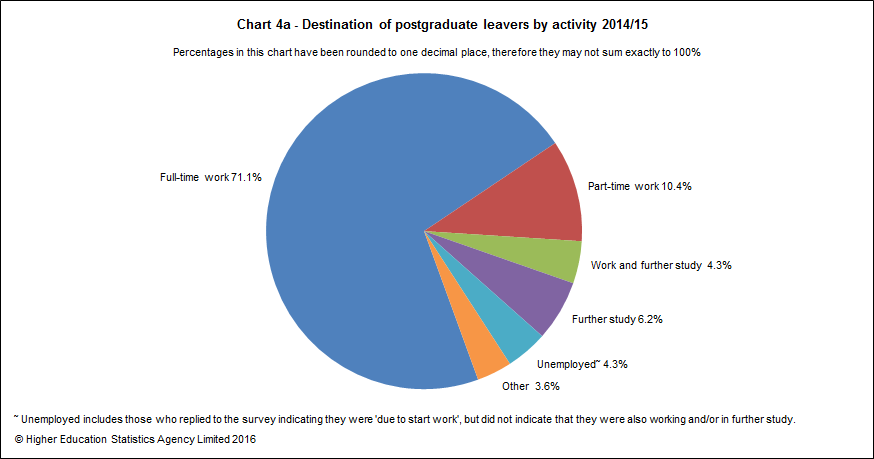
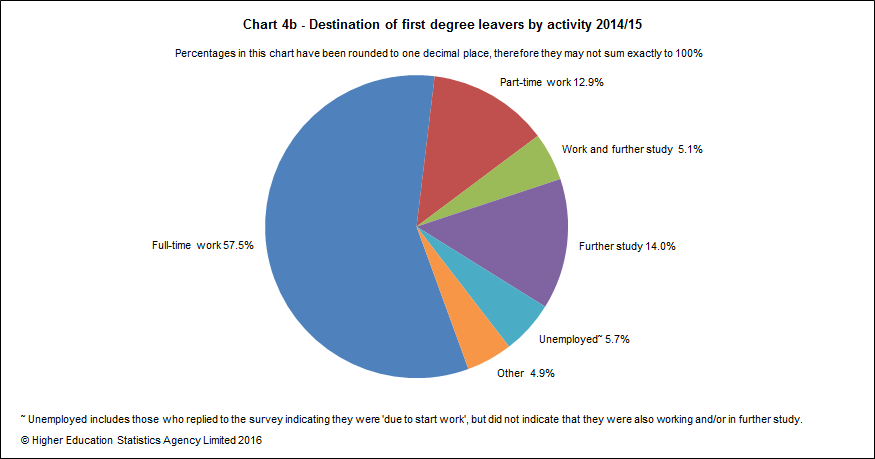
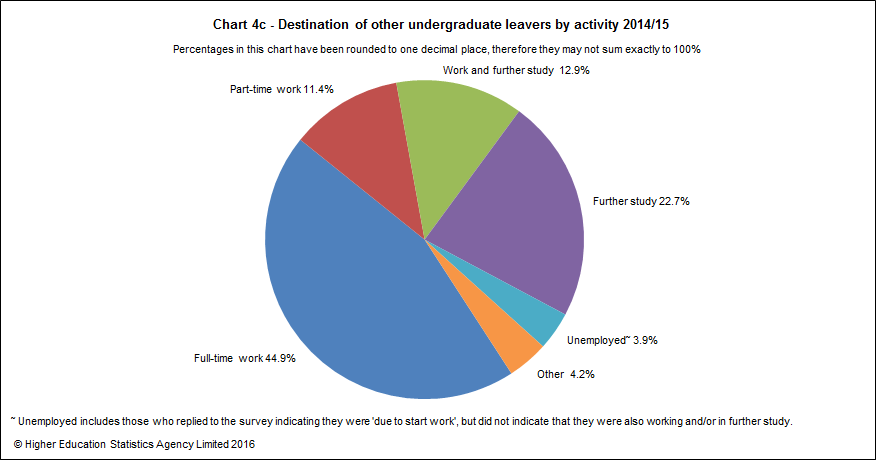
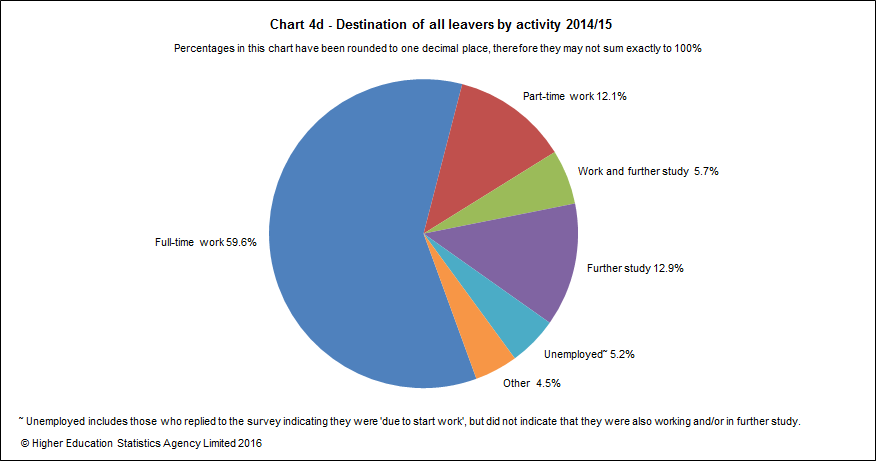
Table F and Chart 5 show how the distribution of leavers by activity varies for each subject area for full-time first degree leavers. Unemployment rates for full-time first degree leavers whose destinations were known varied between subjects, ranging from those which have traditionally low rates of unemployment, such as Medicine & dentistry (0.2%), Veterinary science (0.5%), Education (2.4%) and Subjects allied to medicine (2.4%) to those with higher rates of unemployment, such as Computer science (9.8%), Mass communications & documentation (7.8%), Engineering & technology (7.7%). For all full-time first degree leavers, the percentage unemployed was 5.9%
Full-time first degree leavers having studied Law were the most likely to be engaged in some form of further study (including work and further study, 41.8%), which is a common path to qualification in that profession. In contrast, 92.8% of full-time first degree leavers who studied Medicine & dentistry and 92.8% who studied Veterinary science went into work and 1.8% and 1.5% respectively went into work and further study.
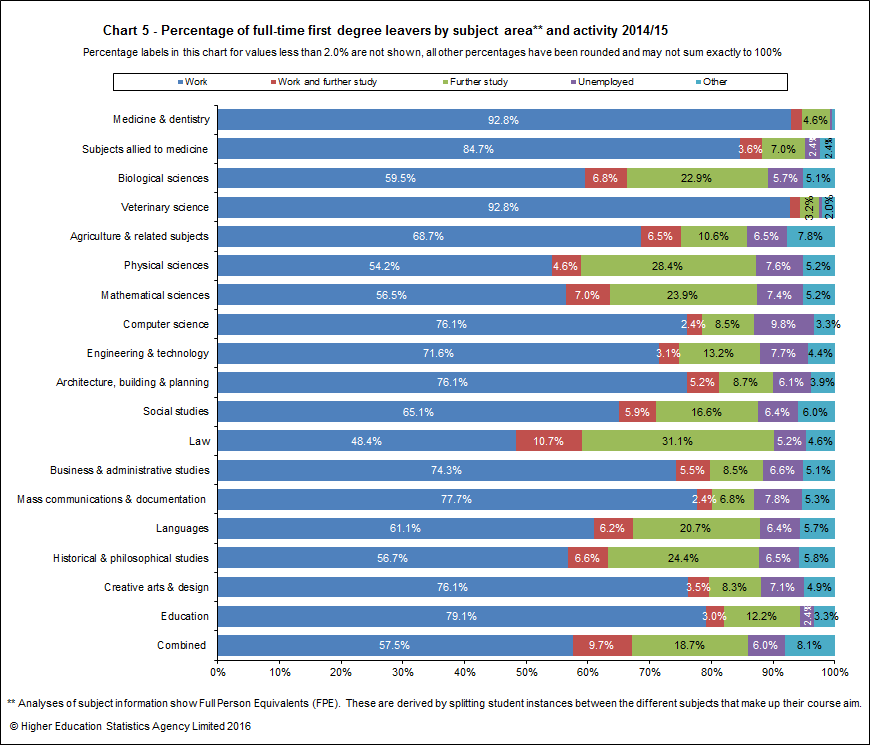
Staff
The HESA Staff Record covers all academic and non-academic staff who have a contract of employment with a UK HEP, or for whom the HEP is liable to pay Class 1 National Insurance contributions.
On 1 December 2014, there were in total, but excluding those staff on atypical contracts (see Definitional support), 403,835 staff, of whom 198,335 were academic and 205,500 were non-academic. In addition, there were 75,560 academic staff on atypical contracts. Non-academic atypical staff are excluded from this publication as HE providers were only obliged to return atypical staff on academic contracts.
The remainder of the staff figures exclude atypical staff. Table G provides a breakdown of academic staff by academic employment marker and mode of employment for the last five years.
Over the last 5 years staff numbers have increased and student numbers have decreased, year on year. Overall staff numbers have increased by 2.1% since last year. Student numbers have decreased by 1.4% since 2013/14 and 9.4% since 2010/11.
Chart 6 illustrates the fluctuations of both students and academic staff over a five year period. It should be noted that the axis scale for staff differs from that of students in order to express both trends on the same chart. Following the regular review of the HESA Staff record there were several changes to the collection of staff data from 2012/13. The changes which impact upon the figures in chart 6 include a change to the method for reporting academic contracts.
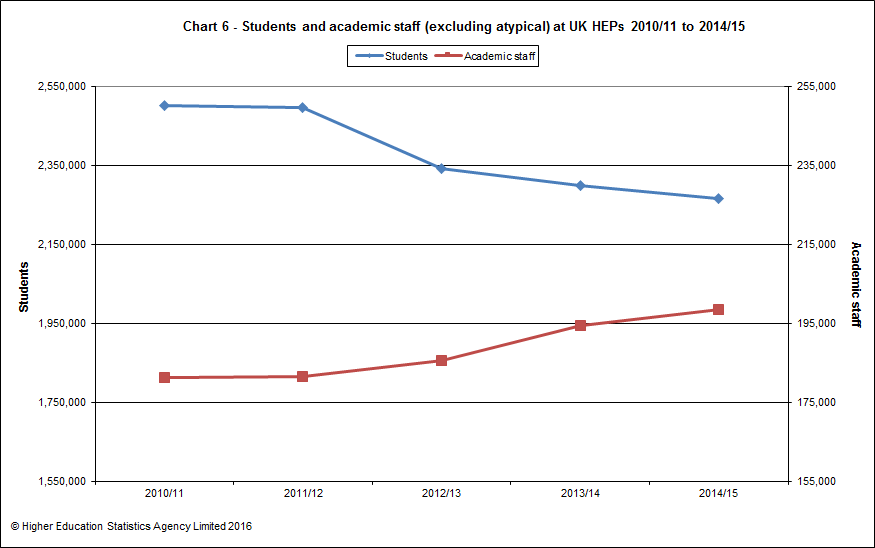
Table H shows academic staff by terms of employment, mode of employment, academic employment function and sex for 2014/15. Overall, there was a higher percentage of male academic staff than female. However, higher percentages of part-time academic staff were female. This was true for both open-ended/permanent and fixed-term contracts.
Chart 7 below illustrates the percentages of open-ended/permanent and fixed-term contract academic staff by academic employment function, mode of employment and sex. It can be seen that staff engaged in both teaching and research were much more likely to be employed on open-ended/permanent contracts than those undertaking only research.
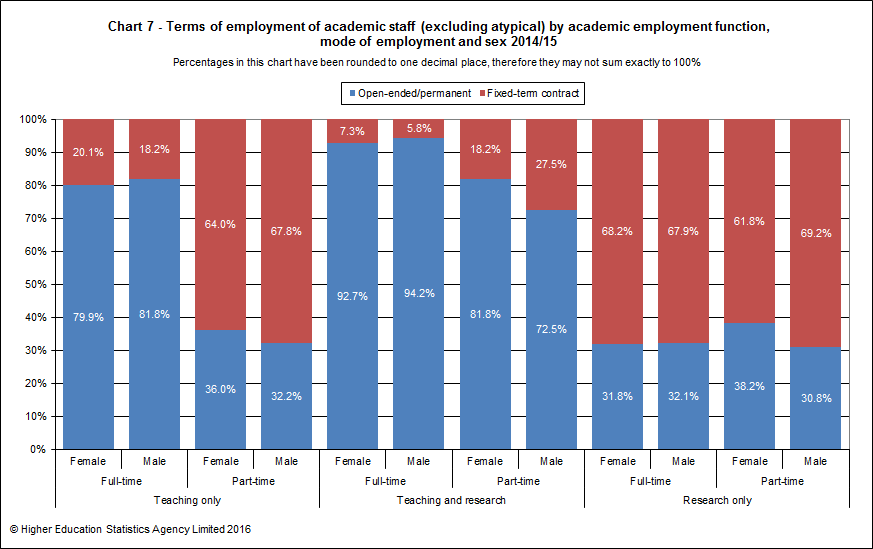
Finance
The finance data collected by HESA from UK HEPs covers income and expenditure. Net income has increased at a slightly higher rate in cash terms (20.6% increase since 2010/11) than expenditure (19.0% increase since 2010/11) with a HE sector surplus across all years.
Table I provides a time series of the income by source and expenditure by type for the last five years.
Chart 8 illustrates the percentage change of the various sources of income over the same period. In particular, the percentage of income from tuition fees and education contracts has increased from 32.6% in 2010/11 to 46.9% in 2014/15, unlike income from funding body grants which has fallen from 32.2% in 2010/11 to 15.9% in 2014/15.
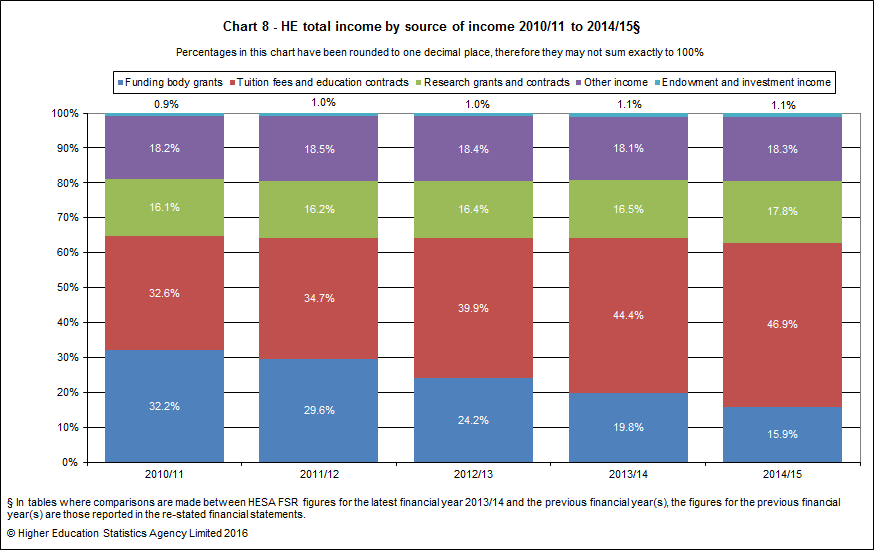
Student Loans
Table J provides information on income from course fees of full-time UK and EU domicile undergraduates (source: HESA) alongside tuition fee loans and maintenance loans paid to HE students (source: SLC). The difference in coverage means that data from these two sources are not directly comparable; however, the figures allow some trend comparisons to be made. Although income of HEPs and loans paid to HE students have increased over time (with the exception of maintenance loans paid to HE students in Wales), the tuition fee loans paid to HE students have increased at a quicker rate, which coincides with changes to the tuition fee arrangements.
© Higher Education Statistics Agency Limited 2016
